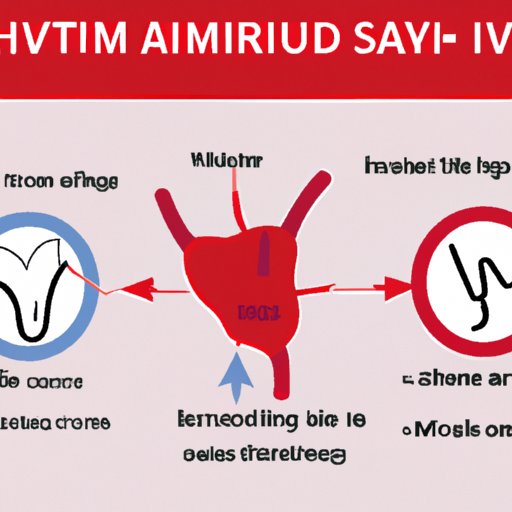
Introduction
HIV, or human immunodeficiency virus, is a serious infection that attacks the immune system and can be fatal if left untreated. It is vital to understand the symptoms of HIV to detect its presence early and reduce the risk of complications. This article explores when HIV symptoms start, how the infection progresses, and how to distinguish early HIV symptoms from other illnesses.
What is HIV and How It Affects the Body
HIV is a virus that attacks the immune system, specifically CD4 cells (also known as T-cells). The virus replicates itself within the cells, eventually destroying them and weakening the immune system. Without treatment, HIV can progress to acquired immunodeficiency syndrome (AIDS), a condition where the immune system is severely compromised and vulnerable to infections and other illnesses.
It is important to detect HIV symptoms early, as early detection can prevent the virus from damaging the immune system irreversibly. With proper treatment and medication, people living with HIV can achieve a normal lifespan and live healthy lives.
The Timeline of HIV Symptoms
HIV symptoms develop in stages and progress slowly over time. The timeline of HIV can be divided into acute and chronic phases.
The acute phase of HIV occurs during the first two to four weeks after exposure and infection. During this phase, the virus rapidly replicates itself, and the immune system responds by producing antibodies to fight the infection.
The chronic phase of HIV follows the acute phase and can last years without symptoms. During this phase, the virus continues to replicate and infect new cells, progressively weakening the immune system. Eventually, symptoms will appear and progress to AIDS if left untreated.
Early Warning Signs of HIV
Early HIV symptoms may not be noticeable or mistaken for other illnesses. These symptoms can appear within two to four weeks after exposure and can include:
- Fever and chills
- Sore throat and swollen glands
- Joint and muscle pain
- Nausea, vomiting, and diarrhea
- Headaches
It is important to note that early HIV symptoms may vary between individuals, and some people may not experience any symptoms at all during the acute phase.
From Exposure to Symptoms
HIV can take several years to progress from exposure to full-blown AIDS. The stages of HIV manifestation are:
- Exposure
- Acute infection
- Chronic phase
- AIDS
Early HIV symptoms appear during the acute phase, and the virus can be transmitted during this time. The chronic phase may not present any noticeable symptoms, but the virus continues to damage the immune system. AIDS is the final stage of HIV, where the immune system is severely compromised, and the person is vulnerable to life-threatening infections and illnesses.
When HIV Symptoms Appear
The timing of HIV symptoms varies depending on the individual and their immune system. Early symptoms can appear within two to four weeks after exposure, but some people may not experience any symptoms for years. The average time between exposure and symptoms is around two to four weeks, but this can vary from a few days to several months.
Common symptoms of HIV infection include:
- Fever and chills
- Night sweats
- Swollen glands
- Weakness and fatigue
- Weight loss
- Frequent infections
- Persistent cough
If left untreated, HIV can progress to AIDS, where symptoms can include:
- Severe weight loss
- Chronic diarrhea
- Persistent fever
- Night sweats
- Memory loss, confusion, and neurological disorders
- Opportunistic infections
Distinguishing HIV Symptoms from Other Illnesses
Early HIV symptoms can be similar to other illnesses, such as the flu or cold. It is essential to consult a doctor if any symptoms persist or worsen. Doctors can perform a blood test to detect HIV antibodies and confirm a positive diagnosis.
Early diagnosis can lead to early treatment and better outcomes. The earlier the treatment starts, the better the chances are of reducing the progression of HIV to AIDS and other complications.
From Infection to Illness
The journey of HIV from infection to illness varies from person to person. HIV symptoms can progress in stages, and each stage is associated with different signs and symptoms. The stages of HIV are:
- Acute infection
- Clinical latency
- AIDS
During the acute phase, symptoms such as fever, rash, and fatigue may appear. These symptoms may go away after a few weeks, followed by the clinical latency phase, where the virus continues to multiply but without any symptoms.
Without treatment, HIV may progress to AIDS, which is characterized by severe immune system damage and life-threatening opportunistic infections.
How Soon After Contracting HIV Do Symptoms Start?
Symptoms of HIV usually appear within two to four weeks after exposure. However, it is possible to have HIV without experiencing any symptoms at all. It is essential to get tested regularly if you are at risk of exposure to HIV, such as having unprotected sex or sharing needles.
If you suspect you have been exposed to HIV or experience any symptoms, seek medical attention immediately. Getting tested and diagnosed early can help prevent HIV from progressing to AIDS and other complications.
Conclusion
Early detection of HIV symptoms is critical to managing the infection and reducing the risk of complications. Understanding the timeline of HIV symptoms, early warning signs, and progression to AIDS is essential for anyone at risk of exposure to HIV. Remember to get tested regularly and seek medical attention if you experience any symptoms or suspect exposure to HIV.
Resources for getting tested and seeking treatment can be found through local health clinics, hospitals, and community organizations.




